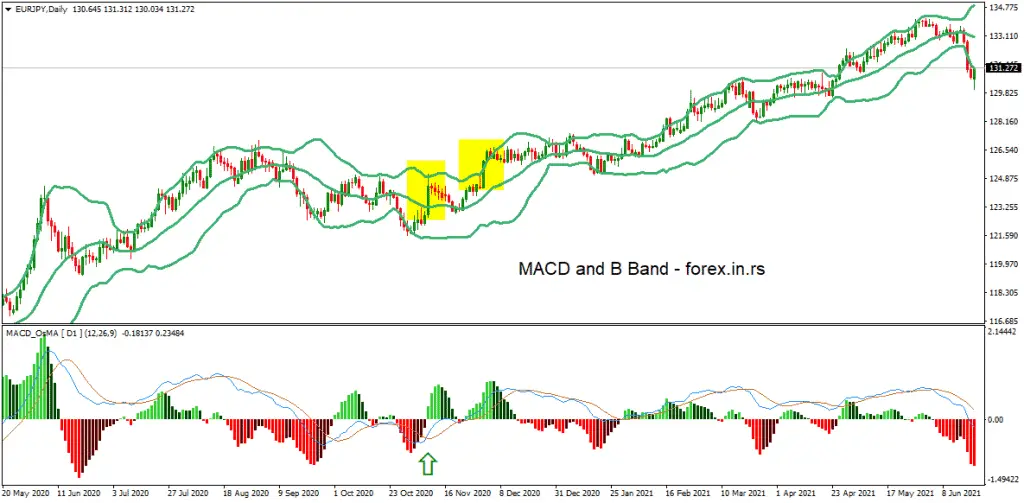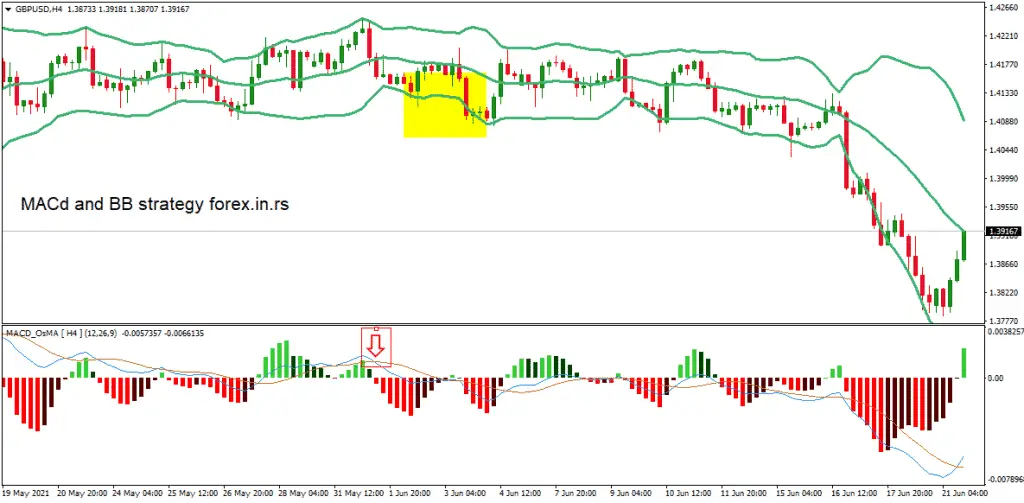Table of Contents
Technical traders can get some priceless advantages from Bollinger Bands®. Once matched with the Moving Average Convergence Divergence (MACD) indicator, it provides traders with liquidity and motion in the forex market. Before we move forward, let’s review the initial points of both the Bollinger Bands and the MACD indicator.
What is MACD and Bollinger Bands Strategy?
MACD and Bollinger Bands Strategy represents the Bollinger Band and MACD combination to determine whether to enter a position during a trend breakout. Usually, the best approach is to enter a trade when MACD shows divergence and Bollinger Band confirms a trend breakout on the H4, Daily, or weekly chart.
To use the MACD indicator correctly, use the Macd 2 line indicator for MT4.
As the heading indicates, the traders use Bollinger Bands®, in connection with MACD, to support deal arrangements. Bollinger Bands® permits traders to look at the sequential nature of the stock or forex market, whereas the MACD is an efficient way to indicate the market’s movement.
Using both indicators can guide traders when making greater trades as they can estimate the route and potential of the present trend, along with the stock market. As an outcome, traders can apply the MACD to judge if a trend is rising in movement or lagging down and be prepared for a probable breakout. Conversely, Bollinger Band® can be utilized as an entering force and consecutive confirmation of a deal.
There are several ways by which a Trader can deal with Bollinger Bands® and MACD, but the two most ordinary ways to trade with those two indicators include breakouts and trend trading.
To learn about the best MACD settings, visit our page.
BB MACD Tutorial – MACD and Bollinger Bands Strategy Steps
- Using MACD to analyze trends on the chart. Watch trendline.
- Determine the price divergence in the MACD histograms (MACD lines crossover)
- Wait for the price break of the 20-moving average on Bollinger Band.
- Wait to see that price touch the upper B band (for buy trade) or down Band (for sell trade).
- Enter into position.
Post to the bullish diversification, a disrupted average of the 20 moving periods (centerline within the Bollinger Bands®) indicates to enter the long trade. The dotted line on the top of the channel symbolizes trendline rigidity and corresponds with the 20 MA of the Bollinger band® when the price disrupts through it. The shattering of those two lines ensures it is significant, promoting support for the bullish bias.
Just as the MACD line goes across the signal line and keeps moving beyond, the MACD indicator promotes the bullish trade, displaying rigid ascending movement. The Bollinger Band then approves the upward movement, as the price starts to “walk the band” on a surged stock market (expansion of the Band).
Stops could be marked beneath the lower Bollinger Band® or at the shallow of the downgoing channel. The goal can be marked at an earlier extensive or substantial sign of resistance – also managing the risk-to-reward ratio. Traders should review multiple levels of goals and manually move stops upward or use a trailing stop, as there are chances of turning a breakout trade into a trend reversal.
MACD and Bollinger Bands Strategy Example
Below are presented MACD and Bollinger Bands indicators on the EURJPY Daily chart and an example of MACd and Bollinger Bands strategy. Yomustto downloads two MACD lines to see the chart’s divergence more easily.

As you can see, you need to determine the moment when MACD lines cross. After that, you wait for the price above MA 20 (middle B. Band line). You can enter into a trade if you see a price that breaks the upper Band; the chart shows a gain from 126.5 to 133 (more than 400 pips).
Trend Trading by Applying Bollinger Bands® and MACD
The Bollinger Band® MACD blend can also be applied in trending markets through the process mentioned below:
- Use MACD to diagnose trends.
- Apply to leap off the 20 MA as possible entry points (within the line of trend)
- Keep an eye on MACD for affirmation of continuity of momentum
- Utilize the decreased (increased) Band to restrain loss in an upward trend (downward trend).
The EUR/USD chart below illustrates Bollinger’s and MACD’s trend-dealing strategy. If both the lines are beyond the zero marks and the MACD line above the signal line, then MACD confirms the uptrend. Hence, a filtrate is adjusted for traders only looking to enter long trades.
As the commencing spike ends in the upward movement, the movement decelerates. Even after the MACD line passes under the signal line, the move area to a lower volume results in a short-term condensation instead of a move opposite to the present trend. The upward trend gets more solid as the price jumps off the 20 MA and prolongs, making more immense highs and lows.
In Correspondence with the Bollinger Band® Squeeze (green arrows), traders can look forward to entering the long trade. Long traders are left with two options. The first is to exit the trade as the price drops to 20 MA or search for a breach of the lower Bollinger Band® as the signal to exit.
Dealers can use trailing stops. Also, it can be physically moved along the lower Bollinger Band® as price hikes. Objectives can be set at specific support and resistance stages while maintaining appropriate risk management.
Benefits and constraints of The Bollinger Bands® and MACD System
What are the Benefits?
Both Bollinger Bands® and MACD apply to any resource at any time interval.
Bollinger Bands® provides stop-loss levels, intersecting with the lower Band for long trades and the upper Band for short trades.
Traders can govern the trend and liquidity of any market by taking a look.
What are the Constraints?
The blend of the Bollinger Band® and MACD is unsuitable for inexperienced traders. The one new to FX trading will need many skills for both Bollinger Bands® and the MACD.
Bollinger Bands® is famous in ranging markets for its performance, while the MACD is a movement indicator that follows trends. If the application is improper, then traders can receive confusing signals.
Bollinger Bands® gives traders a visual representation of the stock market.
Conclusion
After going through all the provided data, it is clear that BB and MACD are beneficial for traders to understand the market’s liquidity, movement, and trend. So, learn about them, practice them in a demo account, and then only employ your real money to work.

























